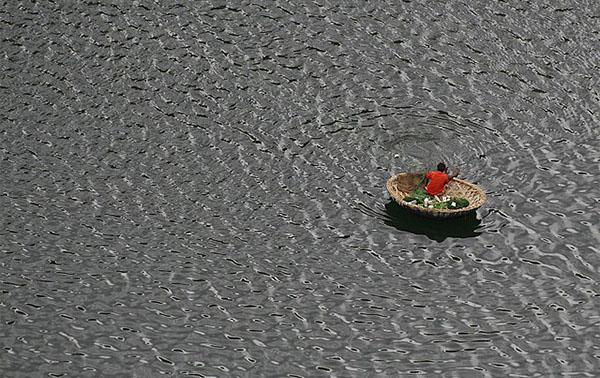In the southern heartland of India, rivers meander like veins of life. From the languid flow of the Kaveri to the spirited rush of the Godavari, these rivers nurture a rich natural heritage. Their waters birth lush landscapes that nurture spices, rice, and diverse flora, shaping the region’s culinary identity.
Coconut-infused curries dance with the essence of river fish, while rice paddies thrive under the sun-kissed blessings of these waters. In each dish, the rivers of the south flow, whispering tales of tradition and flavour, an eternal homage to their enduring legacy.
Indeed, the rivers of the south have played a pivotal role in the development of coastal towns, creating hubs of economic and culinary activity that have thrived for centuries. Let’s explore a few historic examples:
1. Kaveri River and Karaikal: The Kaveri River in Tamil Nadu has nurtured the town of Karaikal, which was historically a prominent trading port. Its strategic location along the river and proximity to the coast made it a vital center for trade and cultural exchange.
2. Krishna River and Machilipatnam: The Krishna River in Andhra Pradesh has shaped the town of Machilipatnam, also known as Masulipatnam. This coastal town was a flourishing trading center during the colonial era, especially for textiles, spices, and indigo.
3. Godavari River and Rajahmundry: The Godavari River, one of the largest rivers in India, flows through the town of Rajahmundry in Andhra Pradesh. This town has a rich history as a trade center, particularly for agriculture and aquaculture products like rice and fish.
4. Palar River and Mahabalipuram: Although smaller in comparison to some other rivers, the Palar River has had a significant impact on the town of Mahabalipuram in Tamil Nadu. This historic town, known for its ancient rock-cut temples and sculptures, developed along the coast due to its access to the river for trade and transportation.
These coastal towns not only owe their existence to the rivers but also owe their vibrant culinary scenes to the bounty of resources provided by these waterways. The interplay of riverine ecosystems, fertile deltas, and coastal influences has given rise to unique culinary traditions that continue to enchant locals and visitors alike.
Kaveri
The Dakshin Ganga
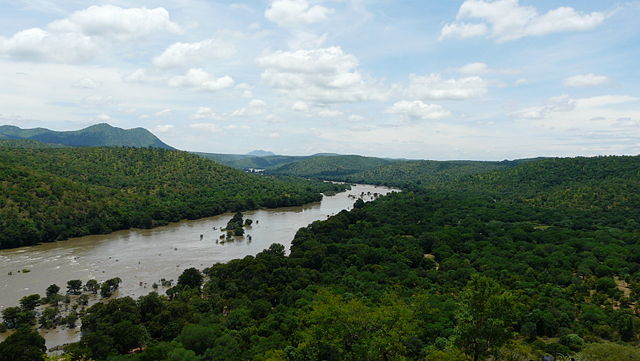
“In every aromatic bowl of bisibele bath (spicy lentil rice) or tangy rasam (tamarind soup), the essence of the Kaveri flows, a reminder of the symbiotic relationship between nature’s bounty and the culinary heritage it inspires.”
The Kaveri River, revered as the Dakshina Ganga (Ganges of the South), meanders through the heartland of Karnataka and Tamil Nadu, leaving a profound mark on both the natural and culinary heritage of the region. Its waters, originating from the lush hills of the Western Ghats, nurture a fertile landscape that yields an array of flavors like Nalla Karam, Malabar tamarind or Byadgi chillies that are unique to this part of the world.
In the quaint town of Srirangapatna, nestled along the Kaveri’s banks, fields of fragrant jasmine and sugarcane sway in the gentle breeze, while farmers cultivate the famed Mysore silk bananas and aromatic Coorg coffee. These agricultural riches find their way into the kitchens of the region, where they are transformed into culinary delights like pesarattu, gutti vankaya, royyala iguru and the various other fish curries that reflect the bounty of the land.
The Kaveri’s influence extends beyond agriculture, shaping the fishing communities along its course. In the delta region of Thanjavur, fishermen ply their trade in the river’s estuaries, reeling in freshwater delicacies like the delectable karimeen (pearl spot fish) and nethili (anchovies), which form the backbone of traditional Chettinad cuisine.
But the Kaveri is not just a source of sustenance; it is a cultural icon deeply ingrained in the fabric of daily life. From the vibrant harvest festivals of Pongal and Ugadi to the sacred rituals performed on its banks like the thula snanam or the sacred dip performed in the month of thula (the Tamil month aippasi), the river holds a revered place in the hearts of the people, symbolizing abundance, fertility, and spiritual purity.
In every aromatic bowl of bisibele bath (spicy lentil rice) or tangy rasam (tamarind soup), the essence of the Kaveri flows, a reminder of the symbiotic relationship between nature’s bounty and the culinary heritage it inspires.
Godavari
A river’s bounty weaving stories of abundance and tradition
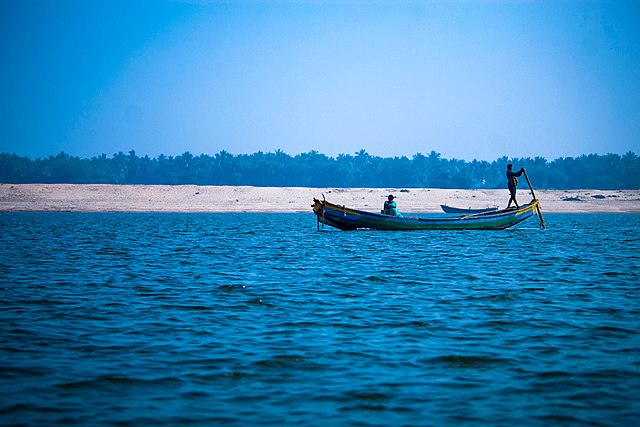
As the Godavari River winds its way through the vibrant landscapes of Andhra Pradesh and Telangana, it narrates a story rich in abundance and tradition. Originating from the dense forests of the Western Ghats, its gentle waters flow through lush valleys and fertile plains, nurturing a diverse natural heritage that resonates deeply within the culinary customs of the region.
In bustling markets like Rajahmundry and Nashik, one can witness the Godavari’s plentiful offerings showcased. Locally sourced ingredients like the fragrant Kurnool rice, renowned for its unique aroma and fluffy consistency, hold a cherished place in the local cuisine. Spices such as the fiery Guntur chili and aromatic Telangana turmeric, cultivated in the river’s fertile delta, infuse dishes such as spicy chicken curries and tangy fish preparations with rich flavors and depth.
Communities along the riverbanks flourish, with fishing being a primary livelihood. They cast their nets into the Godavari’s currents, capturing prized catches like the succulent pulasa fish. This freshwater delicacy is celebrated annually during the Pulasa Fish Festival in Rajahmundry, highlighting the river’s pivotal role in shaping the culinary legacy of the area.
Beyond being a source of sustenance, the Godavari embodies cultural heritage and spiritual significance. Devotees gather at its sacred ghats to partake in rituals and seek blessings, acknowledging the river’s divine presence and its profound impact on their lives.
In each delectable mouthful of fiery Andhra cuisine and every fragrant sip of Telangana tamarind soup, one can taste the essence of the Godavari—a constant reminder of the inseparable connection between nature’s abundance and the culinary treasures bestowed upon the land and its people.
Tungabhadra
Whispers of history in life along the banks of the Tungabhadra
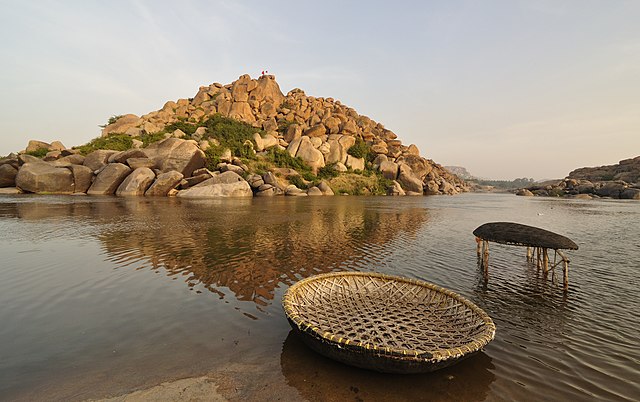
The river Tungabhadra flowed gracefully through the rugged terrain of Hampi, its waters weaving tales of ancient civilizations and cultural heritage. For centuries, it had been a cherished companion to the people of the region, providing sustenance and enriching their way of life.
The banks of the Tungabhadra were adorned with the majestic ruins of the Vijayanagara Empire, standing as silent witnesses to the passage of time. The river had seen the joys and sorrows of countless generations, its currents echoing with the whispers of history.
During the festive season of Mahashivaratri, pilgrims from far and wide gathered at the banks of the Tungabhadra to seek blessings at the Virupaksha Temple. The river became a sacred sanctuary, where devotees immersed themselves in the divine energy of Lord Shiva, finding solace and spiritual renewal in its tranquil waters.
But the Tungabhadra was more than just a religious symbol; it was a vibrant ecosystem teeming with life. The verdant foliage along its banks provided shelter to a variety of animals, from playful monkeys to majestic peacocks. And beneath the surface, schools of fish danced in the gentle currents, their silvery scales glinting in the sunlight.
For the local communities, the Tungabhadra was a source of sustenance and livelihood. Farmers depended on its waters to nourish their crops, while fishermen cast their nets into its depths in search of a bountiful catch.
As the day drew to a close, families gathered on the riverbanks to share laughter, stories, and simple moments of joy. The Tungabhadra was not just a natural wonder; it was a cherished part of their lives, a symbol of resilience and unity that bound them together.
And so, as the sun set on another day, the river Tungabhadra continued to flow, carrying with it the hopes and dreams of those who called its shores home. And in its gentle embrace, they found a sense of belonging and a connection to something greater than themselves.
Krishna
Tales from the Heart of the Deccan Plateau
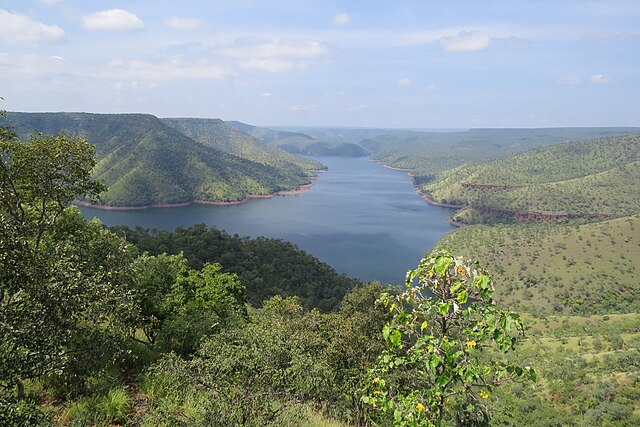
In the heart of the Deccan Plateau, where the sun’s warmth feels like a comforting embrace, flows the life-giving river Krishna. From its origin in the Western Ghats, it winds its way through Maharashtra, Karnataka, and Telangana, blessing the land with fertility and nourishment.
For generations, people have cherished the Krishna not only for its role in agriculture but also for its profound impact on local cuisine. In villages like Sangli, farmers rise early to tend to their fields of sugarcane and grapes, which thrive thanks to the river’s waters. Their produce fills kitchens with the enticing scents of fresh spices and harvests.
In bustling Vijayawada, fishermen embark on colorful boats at dawn, casting their nets wide to catch the river’s bounty. Fresh fish, gleaming in the morning light, find their way to markets and tables, becoming essential ingredients in countless dishes.
Downstream in Kurnool, mango and tamarind trees flourish along the riverbanks. Ripe mangoes add sweetness to chutneys and desserts, while tamarind’s tangy flavor enhances savory curries and sauces.
Yet, it’s in the historic city of Hyderabad where the Krishna’s influence on culinary culture truly shines. Here, the aromatic spices of the Deccan blend harmoniously with coconut and sesame, giving birth to beloved dishes like biryani and kheema.
As the sun sets, casting a warm glow over the Krishna’s waters, communities gather to express gratitude for the river’s blessings. Its gentle flow not only sustains life and prosperity but also weaves together a rich tapestry of culinary traditions that bring people closer across generations. And so, the river Krishna continues its journey, carrying with it the stories of abundance and heritage that define the region.
By – Tusshar Yadav
